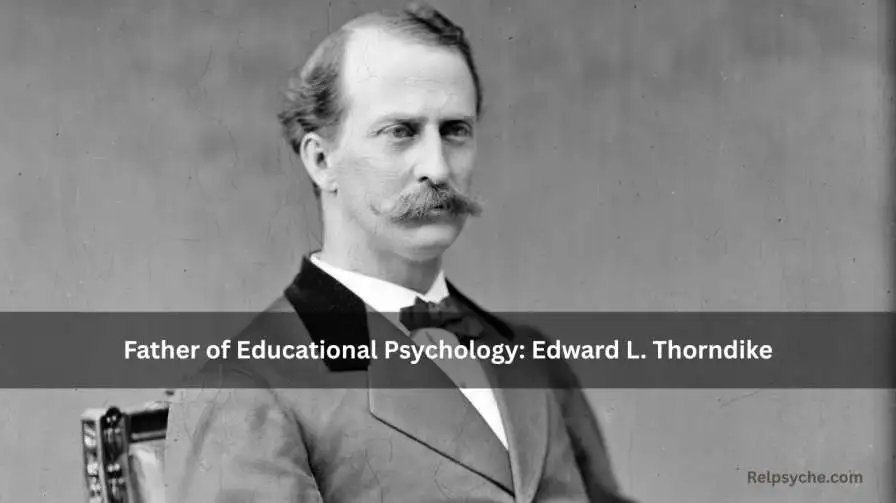Father of Educational Psychology: Edward L. Thorndike
Have you ever stopped to wonder why some students grasp math quickly while others excel in literature? Why are some teaching methods highly effective, and others a waste of time? The field that answers these questions is Educational Psychology, a scientific discipline that studies how humans learn, how instruction can be improved, and how individual differences affect learning outcomes.
The individual credited with establishing this field as a rigorous, scientific discipline is Dr. Edward L. Thorndike. He moved education from being a purely philosophical idea to a science rooted in observation, experimentation, and measurement. Thorndike’s work in the early 20th century provided the foundational principles—the “operating manual”—for modern classroom instruction. Understanding Thorndike’s contributions is essential to grasping the core principles of the father of educational psychology.
This article will explore the life of Dr. Thorndike, detail his groundbreaking experiments, explain his fundamental Laws of Learning, and show why his principles remain vital in schools and training programs today.
Table of Contents
1. Establishing Educational Psychology as a Science
Before Thorndike, educational practices often relied on tradition or simple common sense. Thorndike’s genius was applying the scientific method—traditionally reserved for biology or chemistry—to the study of human and animal learning.
The Journey to the Classroom:
- Early Life and Influence: Born in 1874, Thorndike studied under the renowned American philosopher and psychologist William James at Harvard. He later moved to Columbia University, where he spent most of his distinguished career.
- From Philosophy to Measurement: Thorndike’s most radical belief was that if something exists, it can be measured. He pioneered the use of quantitative methods (statistics and numbers) to study complex concepts like intelligence and learning transfer. This commitment to objective data is what solidified him as the father of educational psychology.
- The Puzzle Box Experiment: Thorndike’s most famous work involved placing cats in a “puzzle box.” To escape and reach food, the cat had to perform a specific action, such as pulling a string or pressing a lever. Initially, the cats struggled, but over repeated trials, the time needed to escape consistently decreased. This showed learning was a gradual process.
- The Discovery of Trial and Error: Thorndike realized the cats weren’t suddenly having an “aha!” moment; they were learning through Trial and Error and forming a connection between the stimulus (being in the box) and the response (pressing the lever). This led directly to his theory of Connectionism.
2. Thorndike’s Three Primary Laws of Learning
Based on his observations in the puzzle box and subsequent human studies, Thorndike formalized the three main Laws of Learning. These laws provide a robust framework for effective teaching and training across all age groups.
A. The Law of Readiness
This law states that learning is most effective when the learner is both mentally and physically ready to receive the information. Readiness is a key psychological state for learning.
- Simple Principle: If a neural pathway is ready to conduct, conduction is satisfying. If it is not ready, forcing it is annoying.
- Classroom Application: A teacher should never introduce a complex concept (like algebra) until the student has mastered the necessary prerequisites (basic arithmetic). Trying to teach an unready student leads to frustration and ineffective learning.
- Real-Life Example: Trying to teach a toddler to tie their shoes when their fine motor skills haven’t developed will lead to tears and failure. The child isn’t “ready.”
B. The Law of Exercise (Repetition)
The Law of Exercise emphasizes the importance of practice and repetition in strengthening learning. It has two parts:
- Law of Use: The more frequently a connection (or piece of knowledge) is used, the stronger it becomes. Practice makes permanent.
- Law of Disuse: Connections that are not used weaken over time. “Use it or lose it.”
- Classroom Application: This law justifies homework, drills, and review sessions. To master a foreign language vocabulary or a complicated scientific formula, repeated practice is essential. Educators use this to design a curriculum that cycles back to previous topics.
C. The Law of Effect
Considered Thorndike’s most significant contribution, the Law of Effect is the precursor to modern behaviorism and the concept of reinforcement.
- Simple Principle: When a response is followed by a satisfying consequence (a reward), the connection between the stimulus and the response is strengthened, and the behavior is likely to be repeated. When a response is followed by an unsatisfying consequence (a punishment), the connection is weakened.
- Classroom Application: Giving a student immediate praise (“Great work on that essay!”) is much more effective than criticizing a mistake. Positive feedback acts as a satisfying consequence that encourages the student to repeat the desired effort and behavior. The effectiveness of motivation techniques relies heavily on this principle from the father of educational psychology.
3. Connectionism and the Idea of Learning Transfer
Thorndike named his theory Connectionism, highlighting that learning is literally the creation of measurable neural bonds. Beyond his famous laws, his work on Learning Transfer fundamentally changed how school curricula were designed.
- The Theory of Identical Elements: Previously, it was widely believed that studying difficult subjects like Latin or advanced mathematics would broadly improve general intelligence and reasoning power across all areas. Thorndike scientifically debunked this idea.
- Thorndike’s Finding: He found that learning in one area (e.g., geometry) only improves performance in another area (e.g., physics) if the two subjects share specific, identical elements (like similar formulas or problem-solving processes).
- Impact on Education: This discovery meant that schools should stop teaching subjects simply for “mental discipline” and instead focus on teaching practical skills and knowledge that share elements with real-world needs and future careers. This shift made education more relevant and efficient.
4. Why Thorndike is Permanently the Father of Educational Psychology
While later psychologists like Piaget and Vygotsky added crucial theories about cognitive development, Thorndike remains the foundation because he established the methodology and the scientific framework for the discipline.
- Measurability and Objectivity: He insisted that education must use objective tests and statistical analysis. This led directly to the development of standardized testing (like the SAT and IQ tests) and educational assessment tools used globally.
- The Teacher as a Scientist: Thorndike empowered teachers by giving them scientific tools. Instead of relying on guesswork, teachers could now apply the Law of Effect (using rewards) and the Law of Readiness to structure lessons logically and predict learning outcomes.
- Focus on the Learner: His work moved the focus from simply what the teacher does to how the learner’s mind works. This student-centered approach is the defining characteristic of modern pedagogy. His work proved that effective teaching is a science, not just an art.

Conclusion
Dr. Edward L. Thorndike earned the title father of educational psychology because he scientifically proved what makes learning work. His fundamental principles—the Laws of Readiness, Exercise, and Effect—are not just historical footnotes; they are the bedrock of effective teaching, whether delivered in a 19th-century classroom or an online learning platform today. Every time a teacher gives a student praise for a correct answer (Law of Effect) or assigns practice problems (Law of Exercise), they are using the enduring science gifted to the world by Dr. Thorndike. His work ensured that education became a measurable, improvable, and profoundly effective field.
Ready to take the next step in your personal growth? Explore expert services — from therapy to life coaching — available on Fiverr.
If you want to read more articles similar to Father of Educational Psychology: Edward L. Thorndike, You Need to Know we recommend that you enter our Psychology category.
FAQs
1. Who is considered the father of educational psychology?
The individual most widely considered the father of educational psychology is Dr. Edward L. Thorndike, due to his pioneering scientific experiments on animal and human learning and his establishment of the field as a rigorous, data-driven science.
2. What is the most important concept developed by the father of educational psychology?
The most important concept is the Law of Effect, which states that behaviors followed by satisfying consequences are more likely to be repeated, and those followed by negative consequences are less likely to be repeated. This is the foundation of modern positive reinforcement in the classroom.
3. Was John Dewey or B.F. Skinner, the father of educational psychology?
No. While John Dewey was a highly influential educational philosopher who championed progressive education, and B.F. Skinner was a major behaviorist who expanded on the Law of Effect (called operant conditioning), neither is credited with founding the scientific discipline itself. That title belongs to Dr. Edward L. Thorndike.
4. How is the Law of Readiness still used in teaching today?
The Law of Readiness is used to ensure prerequisite skills are met before moving on. For example, a teacher will not start division until they confirm all students understand basic subtraction. Modern education technology uses readiness assessments to place students in the correct learning modules.
5. Why did Thorndike use cats in his early experiments?
Thorndike used cats in his puzzle box experiments to study stimulus-response connections in a controlled, measurable setting. He observed how the cats gradually learned through trial and error to escape, which allowed him to formulate his universal laws of learning that he then applied to human beings.
References
- American Psychological Association (APA): For academic standards and ethical guidelines in educational research.
- The Gale Encyclopedia of Psychology: For biographical and theoretical information on Dr. Thorndike and connectionism.
- National Institute of Mental Health (NIMH): For understanding the neurological and behavioral basis of learning and educational processes.
- The Journal of Educational Psychology (APA Publication): Founded on the scientific principles established by Thorndike.

I’m Emma Johnson, a psychologist who loves to write and share ideas.
I enjoy making psychology simple so everyone can understand and use it in daily life.
If you’d like to talk, ask questions, or work together, feel free to reach out.
Let’s learn and grow in the world of psychology together!







